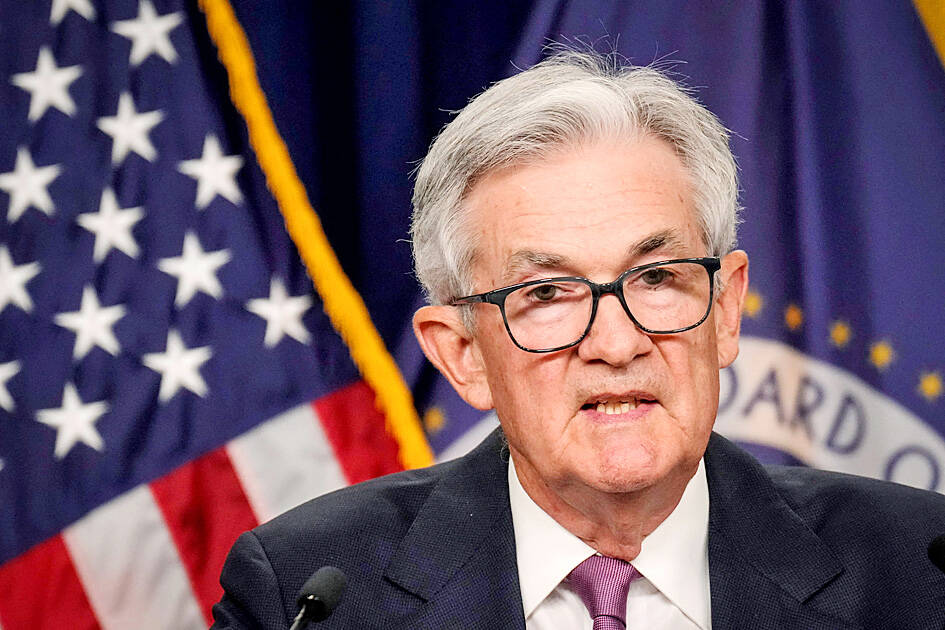The US Federal Reserve on Wednesday voted to pause its aggressive campaign of interest rate hikes despite “elevated” inflation, while indicating a sharp increase could be needed before the end of the year.
“It allows the economy a little more time to adapt as we make our decisions going forward,” US Fed Chairman Jerome Powell said at a news conference after the announcement.
After 10 straight increases, the Fed’s rate-setting committee voted to hold its benchmark lending rate from 5 to 5.25 percent, the US central bank said in a statement.

Photo: AFP
The widely-expected decision gives policymakers on the US Federal Open Market Committee time “to assess additional information and its implications for monetary policy,” the Fed said.
However, committee members hinted that more monetary tightening lies ahead, raising the median projection for interest rates at the end of this year by another half percentage point.
“Looking ahead, nearly all committee participants view it as likely that some further rate increases will be appropriate this year to bring inflation down to 2 percent over time,” Powell said.
The US economy has shown signs of slowing in recent months, with the Fed forecasting a mild recession to begin later this year.
However, despite the Fed’s campaign of monetary tightening, annual inflation remains “elevated” above the US central bank’s long-term target of 2 percent, while unemployment remains low, the Fed said.
Recent indicators suggest that “economic activity has continued to expand at a modest pace,” it added.
The Fed also updated its economic forecast on Wednesday, lifting its GDP growth projection for this year to 1 percent from 0.4 percent in March.
Median inflation expectations for the year nudged down slightly to 3.2 percent, while core inflation expectations, which exclude volatile food and energy prices, rose to an annual rate of 3.9 percent, the Fed said.
The US economy faces “potential headwinds” from tighter credit conditions in the aftermath of the collapse of a number of regional lenders earlier this year, Powell said.
“It may make sense for rates to move higher, but at a more moderate pace,” he said.
US policymakers are “concerned that wage pressures will remain as the labor market remains very tight,” Oanda Corp senior market analyst Edward Moya said.
“With the US banking system remaining resilient and robust job gains, the Fed needs to deliver more tightening and that is why the dot plots [officials’ projections] are pricing in two more small rate hikes,” Moya added.
Most markets in Asia yesterday rose after the Fed decided against hiking interest rates, while the Chinese central bank cut borrowing costs to stimulate the struggling economy.
In Taipei, the TAIEX closed up 96.84 points — or 0.56 percent — at 17,334.98.
Bangkok, Hong Kong, Jakarta, Shanghai, Singapore, Sydney and Wellington all rose, but there were losses in Manila, Mumbai, Seoul and Tokyo.

The US dollar was trading at NT$29.7 at 10am today on the Taipei Foreign Exchange, as the New Taiwan dollar gained NT$1.364 from the previous close last week. The NT dollar continued to rise today, after surging 3.07 percent on Friday. After opening at NT$30.91, the NT dollar gained more than NT$1 in just 15 minutes, briefly passing the NT$30 mark. Before the US Department of the Treasury's semi-annual currency report came out, expectations that the NT dollar would keep rising were already building. The NT dollar on Friday closed at NT$31.064, up by NT$0.953 — a 3.07 percent single-day gain. Today,

‘SHORT TERM’: The local currency would likely remain strong in the near term, driven by anticipated US trade pressure, capital inflows and expectations of a US Fed rate cut The US dollar is expected to fall below NT$30 in the near term, as traders anticipate increased pressure from Washington for Taiwan to allow the New Taiwan dollar to appreciate, Cathay United Bank (國泰世華銀行) chief economist Lin Chi-chao (林啟超) said. Following a sharp drop in the greenback against the NT dollar on Friday, Lin told the Central News Agency that the local currency is likely to remain strong in the short term, driven in part by market psychology surrounding anticipated US policy pressure. On Friday, the US dollar fell NT$0.953, or 3.07 percent, closing at NT$31.064 — its lowest level since Jan.

The New Taiwan dollar and Taiwanese stocks surged on signs that trade tensions between the world’s top two economies might start easing and as US tech earnings boosted the outlook of the nation’s semiconductor exports. The NT dollar strengthened as much as 3.8 percent versus the US dollar to 30.815, the biggest intraday gain since January 2011, closing at NT$31.064. The benchmark TAIEX jumped 2.73 percent to outperform the region’s equity gauges. Outlook for global trade improved after China said it is assessing possible trade talks with the US, providing a boost for the nation’s currency and shares. As the NT dollar

The Financial Supervisory Commission (FSC) yesterday met with some of the nation’s largest insurance companies as a skyrocketing New Taiwan dollar piles pressure on their hundreds of billions of dollars in US bond investments. The commission has asked some life insurance firms, among the biggest Asian holders of US debt, to discuss how the rapidly strengthening NT dollar has impacted their operations, people familiar with the matter said. The meeting took place as the NT dollar jumped as much as 5 percent yesterday, its biggest intraday gain in more than three decades. The local currency surged as exporters rushed to